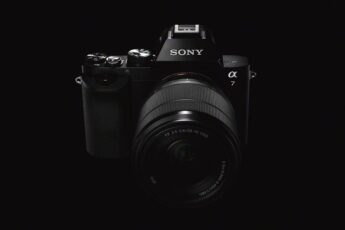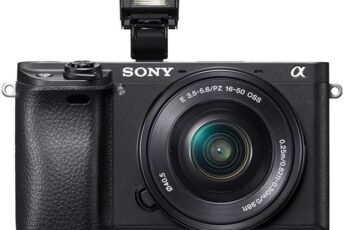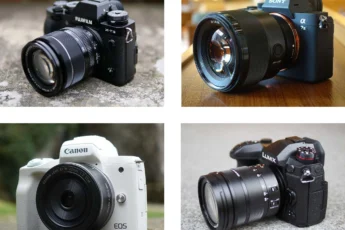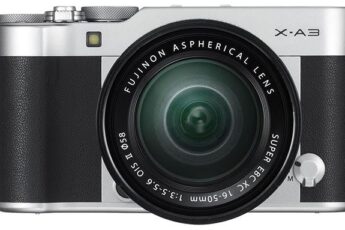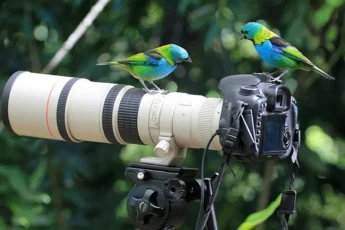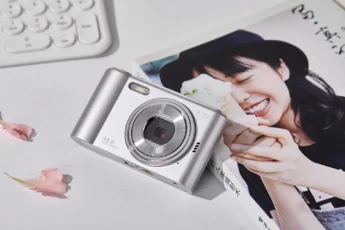With a price of $498.00 with kit lens, the Sony a6000 is considered one of the best entry-level mirrorless cameras on the market. Mirrorless technology is still relatively new compared to the more familiar DSLRs that have been dominant for decades. In addition, the selection of bodies and lenses is noticeably smaller for the mirrorless line, but this is changing rapidly. The popularity of the a6000 silver brings into question the value, image quality, and ease of use for the average user looking to transition to the newer technology. Explore the Sony a6000 with Digital Camera Central below.
Read enough reviews and ready to buy?
- Technical Specifications
- Build Quality
- Image Quality
- How does the Hybrid Autofocus work?
- What additional features does the a6000 silver offer?
- Does the a6000 have Wi-Fi or GPS Connectivity?
- How does the Sony a6000 compare to the Fujifilm X-A3?
- Advantages of the Sony a6000
- Advantages of the Fujifilm X-A3
- How does the a6000 compare to the Sony a6300 and Sony a6500?
- Who is the Sony a6000 for?
- Sample Images
- Final Thoughts
Technical Specifications
- Price: from $398.00 body-only or $498.00 with kit lens
- Kit Lens: The a6000 comes with the Sony E PZ 16-50 mm f/3.5-5.6 OSS Lens. With the 1.5x crop factor, the zoom range works out to an equivalent 24-75 mm. OSS stands for “Optical Steady Shot”. This refers to the in-lens Image Stabilization used to reduce vibrations from hand shake, the shutter, or external motions. However, the camera does not have in-body Image Stabilization, a feature found in other Sony models such as the a6500 and A7ii.
- Sensor: 24.3 Megapixel APS-C sensor, sized 23.5 x 15.6 mm. This sensor has a crop factor of 1.5x compared to a full-frame (35 mm) sensor.
- Number of Autofocus Points: 25 Contrast Detection points and 179 Phase Detection points, creating a Hybrid AF system. 204 is a very large number compared to DSLRs. However, more expensive mirrorless cameras top this number. Still, 204 is an acceptable amount for this tier.
- Built-In Flash: Yes, with multi-interface shoe for extra flash units, continuous lights, and microphones.
- Continuous Shooting: At 11 fps, combined with 179 phase detection points, the Sony a6000 is an excellent choice for shooting and keeping a moving subject in focus. Phase Detection is better at tracking moving subjects rapidly and more accurately compared to Contrast Detection.
- ISO Range: Native ISO 100-25,600, with a Digital Boost option to 51,200. Keep in mind, the “Digital Boost” is an in-camera software rendering of what that ISO would appear like, rather than true sensor sensitivity. Generally, the resulting image will be far too noisy at this ISO to be useful.
- Video Recording Capability: Full HD 1920×1080 video at 24/30/60 fps
- Image Format: The Sony a6000 can shoot in JPEG (in Normal, Fine, and Extra-Fine quality), RAW, and RAW+JPEG at the same time. It uses the two most common image formats in digital photography.
- Wi-Fi Connectivity: The a6000 can connect via Wi-Fi to any smart device or PC using Sony’s Play Memories app. This allows for remote control of the camera, as well as downloading of photos to the smart device or PC.
- Supported Memory Cards: SD, SDHC, SDXC, Memory Stick Pro Duo, Memory Stick Pro-HG Duo
- Battery Life (CIPA rating): 360 shots per charge, an average number for a mirrorless camera. This is low compared to a DSLR. Mirrorless cameras have smaller bodies than DSLRs, which is an advantage, but it also means they use smaller batteries which hold less charge. An extra battery is an excellent purchase, as one can run a battery down in a single shoot.
- Weight: 344 g (0.76 lb / 12.13 oz)
- Dimensions: 120 x 67 x 45 mm (4.72 x 2.64 x 1.77 in)

Build Quality
The a6000 uses a rugged polycarbonate (plastic) body that can withstand minor jostling and the occasional fumble. It does not have the weather sealing of higher end cameras, so avoid wet or dusty conditions. The compactness of its design is immediately apparent to anyone familiar with even the smallest DSLR. Mirrorless cameras have a number of significant advantages over DSLRs; and the difference in size without sacrificing quality is crucial.
Mirrorless cameras make excellent everyday walkabout cameras due to their body size. A DSLR would feel cumbersome, even after the lens has been removed. We’ve all had moments where we wish we had a camera for an unexpected photo, but did want to bring the DSLR around. The convenient size of the a6000 body keeps premium level image capability right in your pocket. However, depending on your pants, it probably won’t fit in your pocket with a lens mounted.
Like all mirrorless cameras, the a6000 does not have an optical viewfinder like a DSLR would. However it does have an electronic viewfinder in the same place a DSLR’s viewfinder is located. Also, you can use the 3 inch, 921K dot Live Viewfinder on the back of the camera. The LiveView screen can be rotated out and tilted in order to give you an excellent view of your subject from any angle.
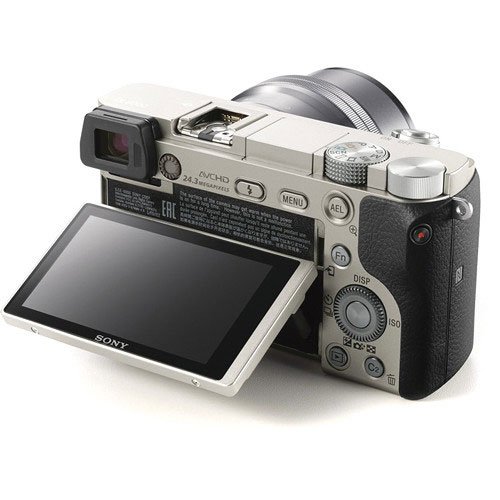
Image Quality
Image Quality is usually the main consideration with any camera purchase, and the a6000 does not disappoint. The APS-C sensor with its crop factor of 1.5x means compared to a full-frame camera, the field of view is slightly reduced. For those unfamiliar to this term, crop factor is a way of comparing the view the smaller sensors of DSLR/mirrorless cameras use to the larger view of a standard 35 mm camera (or full-frame digital sensor). The formula is to take the crop factor and multiply by the focal length of the lens. Using the maximum length of the kit lens (50mm), 1.5 x 50 gives us an effective focal length of 75mm if this were a full-frame sensor.
Despite its size, a 24.3 MP sensor is plenty for capturing rich details in your scenes. Be sure to keep the settings suitable for low-light, or noise will become more rapidly apparent with any crop sensor compared to a full-frame. At 300 pixels per inch, you can print up to 13″x20″ with absolutely no loss in quality, with good quality up to 30″x40″. Most people don’t even need this level of detail; camera makers often obscure otherwise shoddy capabilities with megapixel counts.
The Sony a6000 is an excellent balance of sensor size and megapixel count. If we added more megapixels to the sensor, the individual pixels would become smaller and more prone to interfere with each other. Image noise increases as a result of interference from the pixels being physically closer to each other. Dynamic range (the range of color tones in a scene) and the overall amount of light capable of being collected are also reduced with smaller pixels.
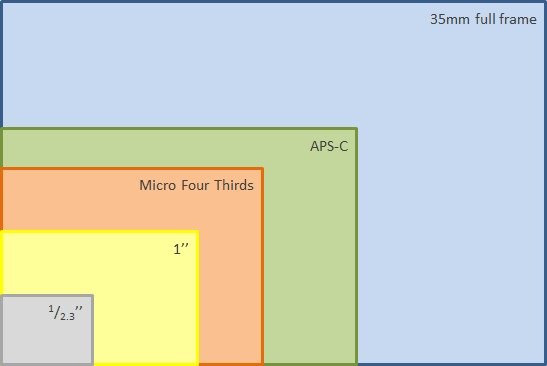
A comparison of sensor sizes.
How does the Hybrid Autofocus work?
Combining phase-detection and contrast detection autofocus is a powerful formula being put to use by most of the newer mirrorless cameras on the market.
For those who do not know, Phase Detection operates by using pairs of sensors to gauge the distance from the subject to the sensor and adjusting the sensors. These sensors are integrated into the main sensor rather than the camera having separate phase detecting sensors, like most DSLRs. The camera has a Contrast Detection sensor that kicks in once Phase Detection has completed its job. Contrast Detection seeks maximum sharpness by looking for peak contrast in the image the sensor is reading, and making adjustments as necessary.
Normally contrast detection requires the camera to pan in and out, “hunting” for proper focus, but combining the two greatly reduces the amount of time required to fine-tune the contrast detection. Those integrated Phase Detection sensors quickly track a subject. The Contrast Detection points and sensor then fine-tune from a much narrower window of focus. According to Sony, the BIONZ X™ image processing of the a6000 operates 35% faster than either the older mirrorless models or comparable mirrorless cameras from other manufacturers.
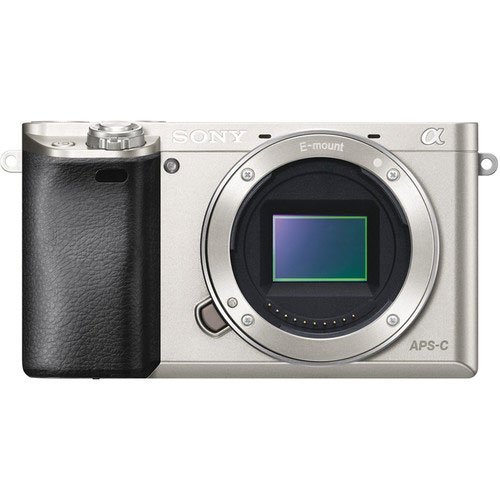
What additional features does the a6000 silver offer?
Like most digital cameras, the has a suite of in-camera options to fine tune photos without any additional software.
Select the Picture Effects setting to gain access to High Contrast Monochrome, HDR Painting, Illustration, Miniature, Partial Color, Pop Color, Posterization, Retro Photo, Rich Tone Monochrome, Soft Focus, Soft High Key, Toy Camera, and Watercolor effects. Each of these can be used to achieve manipulations similar to what a Photoshop menu would offer and are selectively useful. A setting like Monochrome can be done with the most basic software. However, Toy Camera and HDR Painting offer effects that can be difficult to achieve without more advanced software.
Dynamic Range Optimizer is extremely useful as it cleans up harsh shadows or highlights around a bright subject. HDR mode is also exciting, although a tripod is essential when using this mode. The camera takes three images with adjusted exposure levels to bring out the details from shadows and bright areas, and then stitches all three images together with the best qualities of each. HDR photography is extremely popular, and having an in-camera ability to do so is a great option at this price range.
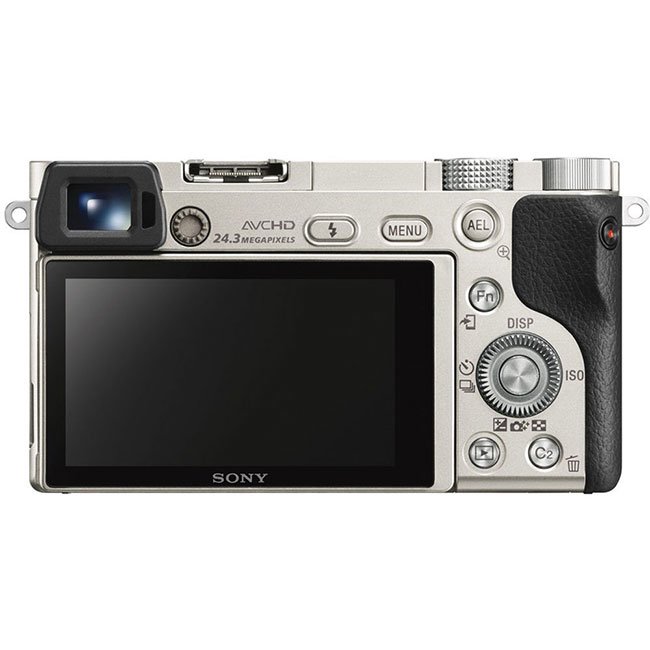
Does the a6000 have Wi-Fi or GPS Connectivity?
The a6000 silver has very limited Wi-Fi connectivity that allows the camera to connect specifically to smart devices that have been configured to recognize it. This means smartphones, tablets, and computers can communicate directly with the camera. In addition, the a6000 has NFC (Near Field Communication) capability, which allows the camera and capable devices to connect with a single touch.
Sony’s PlayMemories App, available for Android or iOS devices, is required to sync your smart device with the camera. You can use the phone or computer as a remote shutter to view and take pictures, which great for a free program. In addition, you can send photos straight to your device, where you can then upload them to the internet. PlayMemories also allows you to tag your photos with location information, which is nice as the a6000 does not have GPS built-in.
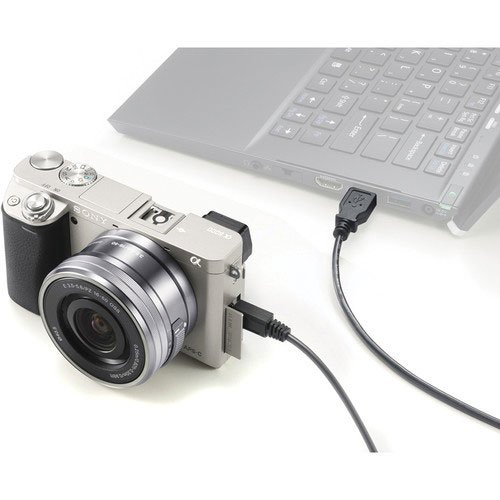
How does the Sony a6000 compare to the Fujifilm X-A3?
The Sony a6000 occupies a slowly growing niche as a preferred beginner level mirrorless camera. They vary quite a bit in their specifications, however one other contender that is quite similar in function, specs, and price, is the Fujifilm X-A3. With a price of $414.22 with kit lens, the X-A3 offers a 24 MP sensor, a slightly smaller ISO Native Range, 49 to 79 AF points depending on the mode used, and the same sized APS-C sensor.
Advantages of the Sony a6000
Greater Native ISO Range: Up to 25,600 vs 6,400
AutoFocus Points: The Sony a6000 has far more points than the X-A3, with 204 compared to 79 maximum with the X-A3.
Faster Continuous Shooting: 11 fps vs 6 fps
Viewfinder: The X-A3 lacks an electronic viewfinder, which can make shooting more difficult as you will have to use the LCD screen.
Slightly Lighter in Weight: 360 g vs 410 g
Advantages of the Fujifilm X-A3
LCD Screen Resolution: The X-A3 offers slightly higher screen resolution (1040K vs 971K).
Touch Screen: The touch screen replaces the need for several buttons on the body. You can zoom in or out, adjust focus, and shoot a subject via touch. The a6000 is controlled via the top dial and buttons on its body.
Battery Life (CIPA rating): 410 vs. 360 shots per charge
Here, we see the reason the a6000 is considered the best beginner mirrorless camera. It is equal or better in terms of most of the features that the X-A3 has to offer, and the disadvantages are quite minimal. The electronic viewfinder and extra AF points are especially nice features.
The electronic viewfinder of the a6000 mimics the optical viewfinder one would use in a DSLR to peer at a subject. It uses a video image of your subject instead of a DSLR’s mirror system. It allows for very natural shooting, holding the camera to one eye as most of us are accustomed to. However, you have the option of using either this or the LiveView panel on the a6000, whereas you must use the LiveView panel on the X-A3 to shoot. And the greater number of AF points on the a6000 allows greater creative control of your resulting image; having more AF points is always useful!
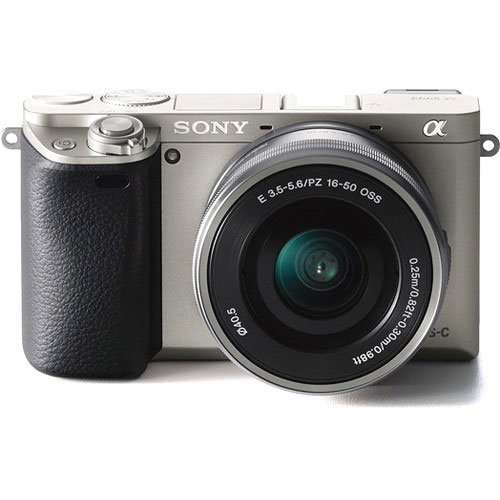
How does the a6000 compare to the Sony a6300 and Sony a6500?
All three have the same 24.3 megapixel APS-C sensor with BIONZ X™ image processing. With a price of from $1,198.00 (body only), the Sony a6500 introduces a front-end LSI chip to the skeleton of the a6000. This does two things: it increases the buffering capacity, or the number of images the camera can hold in memory before transferring to the SD card. And the chip improves the overall image quality by reducing noise artifacts.
The Sony a6300 has a price of from $748.00 for the body only and from $748.00 with kit lens. It does not have an LSI chip, but shares most of what the a6500 has to offer. The Sony a6300 and a6500 both have an upgraded magnesium alloy body for corrosion resistance and increased toughness. In addition, they offer an astounding 425-point hybrid AF sensor over the 179-point of the a6000. With these extra features comes extra weight as both cameras weigh more than the a6000 but are both still lighter than most DSLRs.
The battery life for each is roughly comparable, with 400 shots per charge for the a6300 and 350 for the a6500 (the a6000 is rated at 360). Finally, the a6500 offers 5-axis in body image stabilization. This is a useful feature, reducing blur caused by shaking by up to 5 stops. Stops refers to each step of shutter speed, with each step doubling or reducing the amount of light allowed into the camera. Each major step for shutter speed is at 1/15th sec, 1/30th, 1/60th, and so on up or down the axis of shutter speed. So let’s say I am using the a6500, with its in-body image stabilization. I am using a shutter speed of 1/30th of a second in-hand, with no tripod, and keeping ISO and aperture the same.
A camera without image stabilization (like the a6000) would need a shutter speed of 1/1000th of second to shoot in-hand with the same settings and chance of blur. Any slower a shutter speed and the probability of blur due to handshake increases. This does not mean that every image you take without image stabilization will be blurry, because ISO and aperture are also important. But image stabilization is an excellent feature to greatly reduce the chances of blur when shooting in-hand.
The core strengths of the a6000 are built upon in each version. The a6500 especially, with its LSI chip and image stabilization, is well worth the price for the extra features. But the a6000 is a fine purchase for a beginner with a tighter budget.
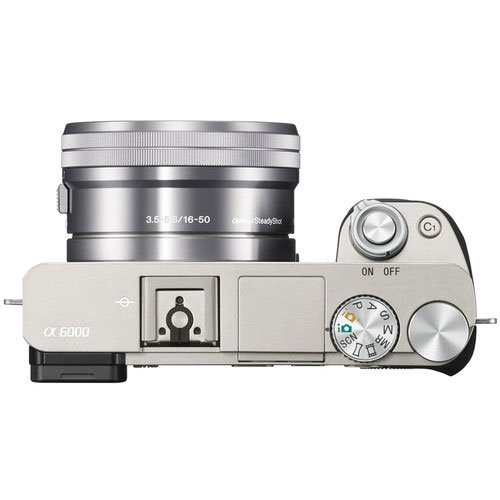
Who is the Sony a6000 for?
With a very reasonable price and simple layout, the a6000 is great for beginners and first time mirrorless camera owners. Hybrid autofocus and an ample number of autofocus points give it an edge in high-speed styles, like sports photography. The a6000 does not have built-in image stabilization. Therefore, a tripod or monopod is even more useful than usual when using a very small depth of field. Depth of field is how much of a given scene is in sharp focus. And without IS, that slice will be even harder to capture.
Sample Images
Final Thoughts
With an excellent suite of beginner, intermediate, and advanced features, the Sony a6000 silver is an excellent value for its price level. For someone looking for a first-time mirrorless camera, the a6000 won’t disappoint in ease of use or image quality. However it is lacking some of the modern in-camera features like Focus Stacking and High Resolution JPEG/RAW modes that are found on pricier models. The a6000 is one of the top-selling mirrorless cameras of all time and comes highly recommended by Digital Camera Central.

















